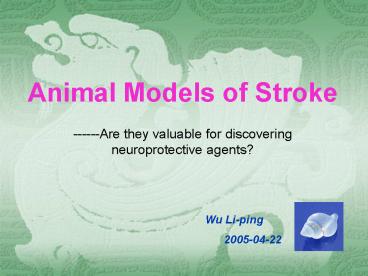Animal Models of Stroke - PowerPoint PPT Presentation
1 / 22
Title: Animal Models of Stroke
1
Animal Models of Stroke
- ------Are they valuable for discovering
neuroprotective agents?
Wu Li-ping 2005-04-22
2
(No Transcript)
3
Therapy of stroke
- 1. Reperfusion
- 2. Neuroprotective agents
4
Table 1. Compounds that have failed recently in
clinical evaluation for the treatment of acute
ischaemic stroke
Compound Mechanism of actiona Inclusion period (h) Outcome (clinical phase) Reason
Selfotel NMDA receptor antagonist 6 Negative (III) Adverse events
Cervene Kappa opioid peptide receptor antagonist 6 Negative (III) Lack of efficacy
Lubeluzole NOS inhibitor and Nat channel blocker 8 Negative (III) Lack of efficacy
Gavestinel Antagonist at the glycine site of the NMDA receptor 6 Negative (III) Lack of efficacy
Enlimomab Anti-ICAM antibody 6 Negative (III) Lack of efficacy and adverse events
Citicoline Cell-membrane stabilizer 24 Negative (III) Lack of efficacy
Ca2 antagonists Ca2 channel antagonists 6-24 Negative (meta-analysis) Lack of efficacy
Aptiganel NMDA receptor antagonist 6 Negative (III) Lack of efficacy
Clomethiazole GABAA receptor modulator 12 Negative (III) Lack of efficacy
BMS204352b Kt channel blocker 6 Negative (III) Lack of efficacy
5
Animal models of stroke
- Global ischaemia
- Focal ischaemia
- Haemorrhagic
6
Table 2. Major animal models of stroke
Type of model Representative models Notes
Global ischaemia Bilateral carotid occlusion Two-vessel occlusion plus hypotension Four-vessel occlusion Primarily in gerbils, rapid screening technique Normally in rats Normally in rats
Focal ischaemia Middle cerebral artery occlusion (1) transient (2) Permanent (3) Thrombotic (1) uses clips, intraluminal thread and snare (2) uses intraluminal thread, clips and coagulation (3) injection of either microspheres or clots into cerebral vessels, including middle cerebral artery
Haemorrhagic Infusion of collagenase into brain
7
Are animal models relevant to the clinical
situation?
- Reperfusion
- Hyperglycemia
- Hyperthermia
- Blood pressure
8
Ischemic damage Reperfusion lt Permanent
occlusion
9
Are animal models relevant to the clinical
situation?
- Reperfusion
- Hyperglycemia
- Hyperthermia
- Blood pressure
10
A worse outcome with hyperglycemia
To reperfused, but not non-reperfused patients or
animals
11
Are animal models relevant to the clinical
situation?
- Reperfusion
- Hyperglycemia
- Hyperthermia
- Blood pressure
12
Hypothermia is beneficial to animal models and
patients of stroke
13
Are animal models relevant to the clinical
situation?
- Reperfusion
- Hyperglycemia
- Hyperthermia
- Blood pressure
14
Why have clinical trials failed despite success
in animal models?
- Drug exposure
- Window of opportunity
- Appropriate animal model
15
Drug exposure
- Adverse events limits the possibility of
achieving the effective dose levels - Much higher dose of compounds is needed in
permanent ischemia
16
Window of opportunity
Treatments
should be given
(Such as reperfusion and compounds)
- Animal models 60-90 min
- at
- Patients 1-2 h
after stroke
17
Appropriate animal model
Post-MCAO
- MCAO model
Pre-MCAO
18
Further improving information from animal models
- Size of histological protection and subcortical
protection - White matter protection
- Length of treatment
- Monotherapy
19
STAIR recommendations
Adequate doseresponse studies and serum
concentrations measured to define minimally
and maximally effective doses. Time-window
studies to confirm efficacy. Physiological
monitoring should be undertaken. Randomized,
blinded studies that give reproducible effects
(one independent). Infarct volume measured
and functional tests used, including
short-term and long-term assessment. Small
rodent studied with permanent middle cerebral
artery occlusion (MCAO) if only model used
is transient MCAO, then reperfusion should
be targeted in clinic. Larger species used
for novel, first-in-class compound. Studies
published in peer-reviewed journal.
20
Additional proposals
Histological protection should be 70 in both
transient and permanent focal ischaemia when
drug is given 1530 min post-occlusion Must
show efficacy in models of permanent MCAO
Should provide subcortical and cortical
protection Attenuates damage to white matter
in brain Time and duration of drug
administration should be appropriate to the
mechanism of action and the proposed clinical
protocol Compound is efficacious as
monotherapy
21
Conclusion
- Animal models
- Having clinical relevance
- To be modified
22
Thank you































